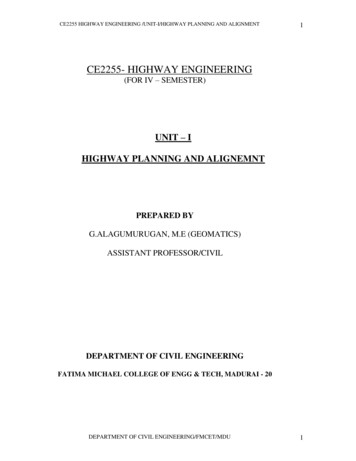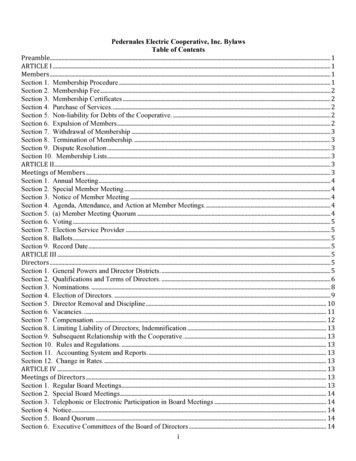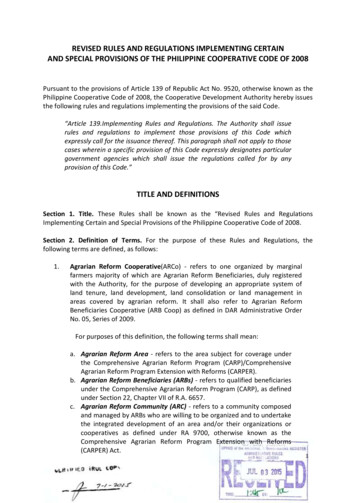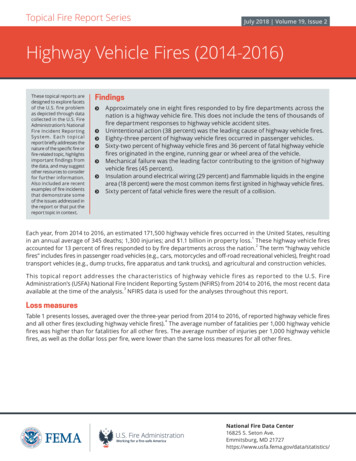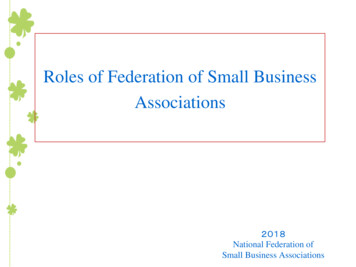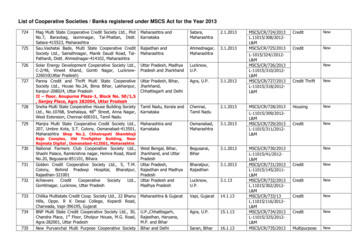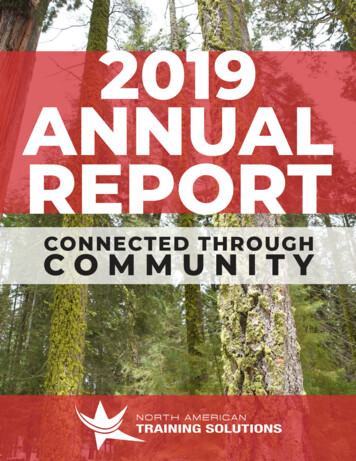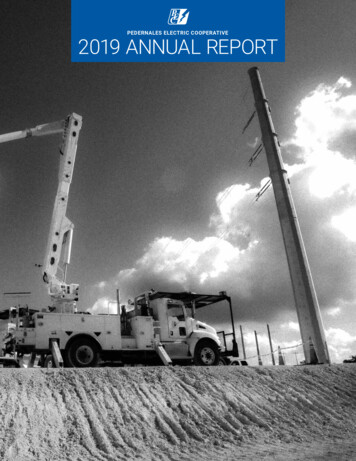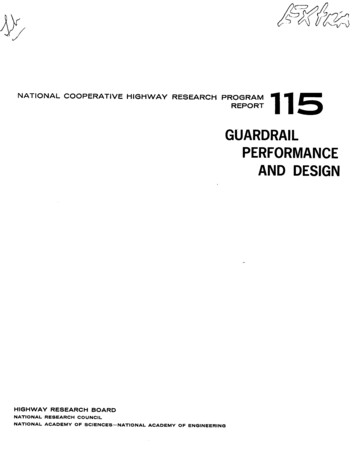
Transcription
NATIONAL COOPERATIVE HIGHWAY RESEARCH PROGRAMREPORT11 5GUARDRAILPERFORMANCEAND DESIGNHIGHWAY RESEARCH BOARDNATIONAL RESEARCH COUNCILNATIONAL ACADEMY OF SCIENCES- NATIONAL ACADEMY OF ENGINEERING
HIGHWAY RESEARCH BOARD 1971OfficersCHARLES E. SHUMATE, ChairmanALAN M. VOORHEES, First Vice ChairmanWILLIAM L. GARRISON, Second Vice ChairmanW. N. CAREY, JR., Executive DirectorExecutive CommitteeF. C. TURNER, Federal Highway Administrator, U. S. Department of Transportation (ex officio)A. E. JOHNSON, Executive Director, American Association of State Highway Officials (ex officio)ERNST WEBER, Chairman, Division of Engineering, National Research Council (ex officio)OSCAR T. MARZKE, Vice President, Fundamental Research, U. S. Steel Corporation (ex officio, Past Chairman, 1969)D. GRANT MICKLE, President, Highway Users Federation for Safely and Mobility (ex officio, Past Chairman, 1970)CHARLES A. BLESSING, Director, Detroit City Planning CommissionHENDRIK W. BODE, Professor of Systems Engineering, Harvard UniversityJAY W. BROWN, Director of Road Operations, Florida Department of TransportationW. J. BURMEISTER, State Highway Engineer, Wisconsin Department of TransportationHOWARD A. COLEMAN, Consultant, Missouri Portland Cement CompanyHARMER E. DAVIS, Director, Institute of Transportation and Traffic Engineering, University of CaliforniaWILLIAM L. GARRISON, Professor of Environmental Engineering, University of PittsburghGEORGE E. HOLBROOK, E. I. du Pont de Nemours and CompanyEUGENE M. JOHNSON, President, The Asphalt InstituteA. SCHEFFER LANG, Department of Civil Engineering, Massachusetts Institute of TechnologyJOHN A. LEGARRA, State Highway Engineer and Chief of Division, California Division of HighwaysWILLIAM A. McCONNELL, Director, Operations Office, Engineering Staff, Ford Motor CompanyJOHN J. McKETFA, Department of Chemical Engineering, University of TexasJ. B. McMORRAN, ConsultantJOHN T. MIDDLETON, Acting Commissioner, National Air Pollution Control AdministrationR. L. PEYTON, Assistant State Highway Director, State Highway Commission of KansasMILTON PIKARSKY, Commissioner of Public Works, Chicago, IllinoisCHARLES E. SHUMATE, Executive Director-Chief Engineer, Colorado Department of HighwaysDAVID H. STEVENS Chairman, Maine State Highway CommissionALAN M. VOORHEES, Alan Al. Voorhees and AssociatesNATIONAL COOPERATIVE HIGHWAY RESEARCH PROGRAMAdvisory CommitteeCHARLES E. SHUMATE, Colorado Department of Highways (Chairman)ALAN M. VOORHEES, Alan M. Voorhees and AssociatesWILLIAM L. GARRISON, University of PittsburghF. C. TURNER, U. S. Department of TransportationA. E. JOHNSON, American Association of State Highway OfficialsERNST WEBER, National Research CouncilOSCAR T. MARZKE, United States Steel CorporationD. GRANT MICKLE, Highway Users Federation for Safety and MobilityW. N. CAREY, JR., Highway Research BoardGeneral Field of DesignArea of General DesignAdvisory Panel C15-1(2)W. A. GOODWIN, University of Tennessee (Chairman)J. L. BEATON, California Division of HighwaysJ. N. CLARY, Virginia Department of HighwaysW. H. COLLINS, Federal Highway AdministrationH. T. DAVIDSON, Connecticut Department of TransportationW. B. DRAKE, Kentucky Department of HighwaysA. L. ELLIOTT, California Division of HighwaysM. D. GRAHAM, New York State Department of TransportationD. L. HAWKINS, Texas Highway DepartmentT. R. HIGGINS, American Institute of Steel ConstructionC. L. HULSBOS, University of New MexicoE. M. LAURSEN, University of ArizonaJ. E. LEISCH, ConsultantD. W. LOUTZENHEISER, Federal Highway AdministrationP. C. SKEELS, General Motors Proving GroundsF. J. TAMANINI, Federal Highway AdministrationF. W. THORSTENSON, Minnesota Department of HighwaysI. M. VIEST, Bethlehem Steel CorporationW. J. WILKES, Federal Highway AdministrationL. F. SPAINE, Highway Research BoardProgram StaffW. HENDERSON, JR., Program DirectorM. MACGREGOR, Administrative EngineerW. C. GRAEUB, Projects EngineerJ. R. NOVAK, Projects EngineerH. A. SMITH, Projects EngineerW. L. WILLIAMS, Projects EngineerHERBERT P. ORLAND, EditorROSEMARY S. MAPES, EditorCATHERINE B. CARLSTON, Editorial Assistant
NATIONAL COOPERATIVE HIGHWAY RESEARCH PROGRAMREPORT115GUARDRAILPERFORMANCEAND DESIGNJARVIS D. MICHIE, LEE R. CALCOTE,AND MAURICE E. BRONSTADSOUTHWEST RESEARCH INSTITUTESAN ANTONIO, TEXASRESEARCH SPONSORED BY THE AMERICAN ASSOCIATIONOF STATE HIGHWAY OFFICIALS IN COOPERATIONWITH THE FEDERAL HIGHWAY ADMINISTRATIONAREAS OF INTEREST:IIGHVVAY DESiGNHIGHWAY SAFETYHIGHWAY RESEARCH BOARDDIVISION OF ENGINEERINGNATIONAL RESEARCH COUNCILNATIONAL ACADEMY OF SCIENCES -NATIONAL ACADEMY OF ENGINEERING1971
NATIONAL COOPERATIVE HIGHWAY RESEARCH PROGRAMSystematic, well-designed research provides the most effective approach to the solution of many problems facinghighway administrators and engineers. Often, highwayproblems are of local interest and can best be studied byhighway departments individually or in cooperation withtheir state universities and others. However, the accelerating growth of highway transportation develops increasinglycomplex problems of wide interest to highway authorities.These problems are best studied through a coordinatedprogram of cooperative .research.In recognition of these needs, the highway administratorsof the American Association of State Highway Officialsinitiated in 1962 an objective national highway researchprogram employing modern scientific techniques. Thisprogram is supported on a continuing basis by funds fromparticipating member states of the Association and it receives the full cooperation and support of the FederalHighway Administration, United States Department ofTransportation.The Highway Research Board of the National Academyof Sciences-National Research Council was requested bythe Association to administer the research program becauseof the Board's recognized objectivity and understanding ofmodern research practices. The Board is uniquely suitedfor this purpose as: it maintains an extensive committeestructure from which authorities on any highway transportation subject may be drawn; it possesses avenues of communications and cooperation with federal, state, and localgovernmental agencies, universities, and industry; its relationship to its parent organization, the National Academyof Sciences, a private, nonprofit institution, is an insuranceof objectvity; it maintains a full-time research correlationstaff of specialists in highway transportation matters tobring the findings of research directly to those who are ina position to use them.The program is developed on the basis of research needsidentified by chief administrators of the highway departments and by committees of AASHO. Each year, specificareas of research needs to be included in the program areproposed to the Academy and the Board by the AmericanAssociation of State Highway Officials. Research projectsto fulfill these needs are defined by the Board, and qualifiedresearch agencies are selected from those that have submitted proposals. Administration and surveillance of research contracts are responsibilities of the Academy andits Highway Research Board.The needs for highway research are many, and theNational Cooperative Highway Research Program canmake significant contributions to the solution of highwaytransportation problems of mutual concern to many responsible groups. The program, however, is intended tocomplement rather than to substitute for or duplicate otherhighway research programs.NCHRPReport 115Project 15-1(2) FY '66ISBN 0-309-01905-2L. C. Card No. 78-610977Price: 3.60This report is one of a series of reports issued from a continuingresearch program conducted under a three-way agreement enteredinto in June 1962 by and among the National Academy of SciencesNational Research Council, the American Association of State Highway Officials, and the Federal Highway Administration. Individualfiscal agreements are executed annually by the Academy-ResearchCouncil, the Federal Highway Administration, and participatingState highway departments, members of the American Associationof State Highway Officials.This report was prepared by the contracting research agency. It hasbeen reviewed by the appropriate Advisory Panel for clarity, documentation, and fulfillment of the contract. It has been accepted bythe Highway Research Board and published in the interest ofeffeotive dissemination of findings and their application in the formulation of policies, procedures, and practices in the subject problemarea.The opinions and conclusions expressed or implied in these reportsare those of the research agencies that performed the research. Theyare not necessarily those of the Highway Research Board, the National Academy of Sciences, the Federal Highway Administration,the American Association of State Highway Officials, nor of theindividual states participating in the Program.Published reports of theNATIONAL COOPERATIVE HIGHWAY RESEARCH PROGRAMare available from:Highway Research BoardNational Academy of Sciences2101 Constitution AvenueWashington, D.C. 20418(See last pages for list of published titles and prices)
FREIN RDBy StaffHigh way Research BoardThis report is recommended to highway design engineers, safety engineers, researchers working with traffic barrier systems, and others concerned with highwaysafety. It contains an overview of guardrail and median barrier technology, summarizes the results of 25 full-scale crash tests, and reports on the relative performance of the designs tested. The findings reinforce material published previously inNCHRP Report 54 and offer additional information on traffic barrier systems.There is a need to provide highway design engineers with a choice of effectiveguardrail and median barrier systems. The volume of research conducted in thepast on the more commonly used designs (W-beam, standard cable, box beam)prompted the need for a comparison and critical analysis to determine what furtherinvestigations were necessary to refine structural details and obtain more effectivebarrier performance. Full-scale testing, necessary to fill in the apparent gaps in previously concluded investigations, was required.Southwest Research Institute (SwRI), San Antonio, Texas, undertook theresearch need outlined above as a follow-on to initial state-of-the-art work conductedby Cornell Aeronautical Laboratory under NCHRP Project 15-1 and reported inNCHRP Report 36, "Highway Guardrails—Review of Current Practice." Furtherwork on establishing the state-of-the-art and synthesizing the information availablewas conducted by SwRI as an early part of NCHRP Project 15-1(2) and wasreported as NCHRP 54, "Location, Selection, and Maintenance of Highway Guardrail and Median Barriers."The remainder of the research effort on Project 15-1(2) is presented in thisdocument—the third in the series of NCHRP Reports on guardrails and medianbarriers. The findings reported herein generally reinforce data presented in NCHRPReport 54 and offer additional insight into the relative performance of various designs, guardrail-bridge rail transitions, and guardrail terminal designs. Informationis included on mathematical modeling, full-scale crash tests, and various evaluationtechniques for comparing the relative effectiveness of the designs investigated. Findings on vehicle response and damage might be particularly interesting.A 16-mm sound and color motion picture (10 minutes), entitled "GuardrailPerformance and Design," summarizes the results of the SwRI work under Project15-1(2). Loan copies of the film are available by contacting the Program Director,NCHRP.The research reported herein brought to light that NCHRP Report 54 couldbe updated to include the latest knowledge available; that it was an appropriate timeto consider the incorporation of all available knowledge on warrants, service requirements, and design criteria for all types of traffic barrier systems into one document; that new concepts for end and transition designs for guardrail and medianbarrier are required; and that promising new design concepts should be evaluatedthrough a program of full-scale crash testing.In response to these additional research needs, NCHRP contracted with Southwest Research Institute to undertake additional work, scheduled to be completed inNovember 1971. There is a possibility that NCHRP publications will be issued inthe near future to update NCHRP Report 54 and also to provide a design guide forall traffic barrier systems. A report on end and transition designs is anticipated tobe issued by NCHRP in early 1972.
CONTENTS1SUMMARYPART IIntroduction and Research Approach4CHAPTER ONE4CHAPTER TWOGuardrails and Median Barriers—A Summaryof the TechnologyBasic ConfigurationsFunctional CharacteristicsDevelopment Procedures26Research ResultsCHAPTER THREEData from Full-Scale Crash TestsVerification of Analytical Predictive ProceduresParametric Studies40CHAPTER FOURAppraisal and Application of ResultsAppraisalApplication45CHAPTER FIVEConclusions and Suggested ResearchConclusionsSuggested ResearchPART II47APPENDIX A64APPENDIX H66APPENDIX CFull-Scale TestingTentative Method of Test for Dynamic Performance of Highway Guardrail and Median BarrierBibliography
ACKNOWLEDGMENTSThe work reported herein was conducted at Southwest Research Institute by the Department of Structural Research.Jarvis D. Michie, Group Leader, and Lee R. Calcote, SeniorResearch Engineer, served as principal investigators. Assistingthe principal investigators were Maurice E. Bronstad, SeniorResearch Engineer, who supervised the full-scale crash testprogram; L. F. Greimann and R. E. Kirksey, who performedmany of the computer tasks; J. R. Cromack, who providedtechnical assistance with crash severity and damage evaluation;W. H. McGinnis, who was responsible for electronic instrumentation; and C. A. Walker and L. B. Ferguson, who wereresponsible for crash test photography. R. C. DeHart, Director,and L. U. Rastrelli, Assistant Director, served in the capacityof technical and administrative advisors.The assistance and cooperation of many persons in statehighway departments, manufacturing firms, and governmentagencies are gratefully acknowledged. In particular, cooperation from personnel with the California Division of Highways,the New York Department of Transportation, the GeneralMotors Proving Grounds, the Bureau of Public Roads, andthe Texas Transportation Institute proved invaluable to theprogram. Cornell Aeronautical Laboratory provided manyreference documents collected under Project 15-1. The General Motors Proving Grounds provided the anthropometricdummy used in all full-scale crash tests; guardrail and medianbarrier materials used in the 25 full-scale crash test installationswere donated by Armco Steel Corporation, U.S. Steel Corporation, Aluminum Association, Texas Wood Preservers AdvisoryCouncil, Syro Steel Company, and Carroll ManufacturingCompany.
GUARDRAILPERFORMANCEAND DESIGNSUMMARYThis research involved the in-depth study of the more common highway guardrailand median barrier systems. Findings are derived from three interdependent areas:(1) state-of-the-art review, (2) theoretical examination of the vehicle-barriercollision, and (3) 25 full-scale crash tests of selected barrier systems.The purpose of a highway barrier is to reduce the severity of ran-off-the-roadaccidents. Barrier installations are warranted (or justified) only at highway locations where the consequence of an errant vehicle leaving the roadway is judgedto be more hazardous than the impact with the barrier installation. This relativeaccident severity determination is valid regardless of whether one or one thousandvehicles leave the highway at a site. Hence, accident frequency is not a principalfactor in determining barrier warrants; however, accident frequency factors doassist in establishing a preferred order of construction of two or more warrantedinstallations.A six degree-of-freedom mathematical model was found to be useful indescribing dynamic behavior of a vehicle during impact. Predictions of vehicleand barrier behavior correlated with results obtained from full-scale crash tests.Crash conditions simulated with a computer were used to identify and evaluatevehicle static and dynamic as well as barrier parameters. Vehicle weight, yaw massmoment of inertia, and deformation constant were found to be significant. Asexpected, such vehicle dynamic parameters as impact speed and angle were themost important factors in vehicle-guardrail interaction. The significant barrierparameters were ascertained to be those related to post strength, vehicle-barriercoefficient of friction, soil modulus, and beam tension; these appreciably influencethe acceleration intensities induced in the vehicle during redirection. For thesystems examined, it was found that vehicle lateral accelerations were higher withrespect to suggested human tolerance levels than the longitudinal accelerations withrespect to their corresponding suggested levels. For a standard test (i.e., 4000-lbvehicle, 60 mph, and 25-degree impact), the vehicle acceleration predictions whencompared to suggested human tolerance levels indicate that occupants need bothlap belt and chest harness restraints to avoid serious injuries.To facilitate comparisons of barrier systems on the basis of dynamic performance, the order in which the three most significant factors need be consideredwas established as being: ( 1 ) barrier structural integrity as determined by whetheror not a system can redirect a selected errant vehicle, (2) vehicle accelerationsduring redirection, and (3) post-impact trajectory of the vehicle. Unless a systemhas demonstrated the ability to redirect a vehicle such that it does not vault over,wedge under, or break through an installation, there is no need to give furtherconsideration to performance criteria related to subsequent events. On the other
APPRAISAL OF GENERAL PERFORMANCE CRASH TESTSG2/W-BeamG3/Box:Beam64/Blocked-Out W-BeamG5/Blocked-Out W-Beam(Steel Post)MB3/Box BeamMB7/Alum. Beam411SYSUM DESIGNATIONTest 15.7None12.5W315.7None6.5W315.7None9.3W8 X 8 Tim.86.25W8 X 8 Tim.86.25W8 X 8 STALLATIONBeamPostOffset (in.)Post Spacing (ft)TEST CONDITIONSVehicle Speed (mph)Vehicle Weight (lb)Impact Angle (deg)DYNAMIC FACTORS*Barrier StrengthVehicle Long. Accel.Vehicle Lateral Accel.Vehicle ReboundUPROPERTY DAMAGE FACTORS*Barrier DamageVehicle DamageBARRIER PERFORMANCEAPPRAISALA-excellent; B-good; C-fair; D-poor; S-satisfactory; and U-unsatisfactory."Recommended height of rail has been revised subsequent to test program.(1) Beam was partially severed.
3hand, for systems that satisfy this basic requirement the evaluation procedure nextconsiders vehicle accelerations; these vehicle acceleration values serve as indicatorsof the severity of redirection and may be used in projecting possible injuries orfatalities among vehicle occupants. Finally, when the first two factors are equal oracceptable, vehicle exit trajectory becomes a critical criterion as it reflects thehazards presented to other traffic. The rebounding vehicle can be the cause of amulticar collision. The number of such accidents cannot be deduced from currentaccident statistics; however, it is conjectured to be quite small.The 25 full-scale crash tests consisted of 14 general barrier performance tests,8 end treatment tests, and 3 guardrail-to-concrete parapet transition tests. Appraisals of the general performance tests are given in the accompanying table.Findings included:The G2 system demonstrated good dynamic performance and causedmoderate property damage. Post spacing can be decreased from the standard12.5 ft to 6.25 ft to effect a 20 percent decrease in system dynamic deflection.Vehicles impacting the G4 system were redirected at moderate to largeexit angles. The 8-in. blockout reduced the tendency but did not prevent wheelsnagging at posts. Vehicle damage for this relatively rigid system was more severethan for the more flexible G2 system. Southern yellow pine was determined tobe a suitable alternate to Douglas fir for the posts and blockouts.Vehicle "rebound" from the G3 and MB3 barrier system was excellent,as the test vehicles remained in contact with or very close to the box beam throughout the exit trajectories.The G5 system, consisting of a W-beam and 6138.5 steel posts, demonstratedgood to excellent dynamic performance and property damage appraisal.Aluminum Association strong beam median barrier demonstrated gooddynamic performance for a moderate speed test; however, the installation waspenetrated for standard test conditions. Metallurgical analysis of the failed beamsplice by the Aluminum Association indicated that the beam had been extrudedfrom an incorrect alloy. Results of subsequent full-scale crash test performed bythe research agency on the aluminum barrier system indicated acceptable barrierperformance.For the 14 tests, average barrier installation damage was 228; averagevehicle damage was 910.Ramped terminal treatments presented in NCHRP Report 54 were found tocause the test vehicles to launch, roll, and tumble. Only the G3 flare treatmentperformed satisfactorily; a single test, however, cannot be considered as conclusiveevidence of design adequacy.In the guardrail-to-rigid bridge rail transition tests, it was demonstrated thaterrant vehicles can be redirected; however, the redirection may be abrupt. Principalfeatures of the transition are that the approach barrier beam is securely anchoredto the concrete parapet and is laterally stiffened in the vicinity of the parapet bylarger and more closely spaced posts.
4CHAPTER ONEINTRODUCTION AND RESEARCH APPROACHThe objectives of NCHRP Project 15-1(2) were to:(1) critically analyze existing data on guardrail performance and identify the most significant needs for additionalapplied research and basic engineering studies, (2) conductsuch full-scale performance tests as were deemed necessary,and (3) evaluate the performance of various guardrail andmedian barrier systems by utilizing vehicle response, occupant injury vulnerability, and property damage as a measureof accident severity.This report is the third of three documents reporting onresults of NCHRP Project 15-1. NCHRP Report 36,authored by Cornell Aeronautical Laboratory, presents astate-of-the-art review of barrier technology prior to 1967.NCHRP Report 54, "Location, Selection, and Maintenanceof Highway Guardrails and Median Barriers," was preparedas an interim report * to Project 15-1(2). Its purpose wasto provide an up-to-date, concise instructional manual forhighway design engineers with respect to various featuresof the commonly used, tried, and proven systems in existence. NCHRP Report 54 will be referred to occasionallyin this report; however, an attempt was made to minimizeduplication of content.During the study, information pertaining to all phases ofbarrier technology was assembled, reviewed, and appraised.The information was acquired from technical literature, test* A special NCHRP advisor group (consisting of John L. keaton, California Division of Highways; Malcolm D. Graham, New York Departmentof Transportation; James Lacy, Federal Highway Administration; and PaulC. Skeels, General Motors Proving Ground) advised and counseled the program staff as to content of the report.reports, and state highway department design standards, aswell as from interviews and discussions with engineersknowledgeable in one or more aspects of the subject. Thisinformation provided necessary background for establishinga state-of-the-art in guardrail and median barrier designrequirements and deficiencies in performance.Initially, the project staff planned to acquire barrier performance data from (1) mathematical modeling, (2) subscale laboratory modeling, and (3) full-scale crash tests.However, the subscale laboratory modeling effort was discarded early in the program because it did not appear tohave the same payoff as that offered by the other twoapproaches.In the chapters that follow, program findings are presented. Initially, a brief summary of the technology is discussed in order to establish a frame of reference withinwhich the program results are identified; included are location warrants and guardrail and median barrier systemground rules. Results from 25 full-scale crash tests arecompared and analyzed. Data obtained trom the parametric studies performed with the six degree-of-freedommathematical model are depicted in plots and discussed.A subsequent appraisal of the program results containsinterpretive commentaries on their application and the typeof action that may be necessary to implement the findingsto advantage. The last chapter deals with conclusions andsuggested research. The appendices contain treatments oftechnical areas and detailed test data considered appropriateto the objectives of the project.CHAPTER TWOGUARDRAILS AND MEDIAN BARRIERSA SUMMARY OF THE TECHNOLOGYAs traffic barrier systems located along highways, the primary function of guardrails and median barriers is to safelyredirect errant vehicles. Guardrail installations on shouldersprevent vehicle access to steep embankments or fixed objects, whereas median barriers are used between the roadways of divided highways to prevent "across-the-median"collisions with opposing traffic. Properly designed installations accomplish the redirection of errant vehicles in such amanner as to minimize the vulnerability of vehicle occupantsas well as the involvement of following and adjacent traffic.Other desirable guardrail and median barrier characteristicsinclude minimal damage to vehicles and barrier systems;economy in construction, installation, and maintenance;enhancement of highway aesthetics; and performance asheadlight glare screens or highway delineators. But although these last functions are of importance, they cannot
be used to justify a design modification wherein the crashinjury reduction capabilities of a system are comptoitiised.In the following sections, certain results obtained duringthe reseaicli ate combined with those of a comparablenature from other investigations. The intent is to identifycertain salient aspects which, in combination, define thegoverning guidelines for guardrails and median barriers asa technology, and form the basis for rational approach tothe effective use of such systems by highway designers.BASIC CONFIGURATIONSCenter Sections'Guardrail and median barrier systems, generally tailored forspecific highway requirements at a given site, are commonlyclassified according to lateral stiffness (see Table 1). Rigidbarriers are normally used where lateral deflections are notpermitted; such locations as narrow medians are examples.Because these systems must be essentially unyielding, theyare almost exclusively constructed of massive sections ofconcrete. The State of New Jersey has had satisfactoryservice with its standard rigid barrier (Fig. IA); Californiahas performed three crash tests on the New Jersey designand reported good results (75). General Motors ProvingGround modified the New Jersey barrier profile (Fig. 1B)and crash-tested the device; improved barrier performancewas reported (48).Most foreign countries have experienced dissatisfactionwith their current rigid barriers, and one country (Germany) has discontinued the use of its standard rigid barrier(Fig. lC). The Trief barrier (Fig. iF) has been proven tobe unsatisfactory by tests conducted by the United Kingdomand the Netherlands. Tests conducted by the United Kingdom and the Netherlands also indicate that the Dansk AutoVaern (Fig. 1E) conceived by Denmark is unsatisfactory.The Trief and D.A.V. barriers were judged to be too low inrelation to a vehicle's center of gravity.Depending on structural behavior, semirigid barriers can* That portion of an installation exclusive of upstream and downstreamterminals.be classed into two groups: (1) strong beam/strong post,or a balanced design, and (2) strong beam/weak post.Semirigid guardrails and median barriers are shown inFigures 2 and 3, respectively.The most common barrier/guardrail system in use is astrong beam/strong post design consisting of a corrugatedsteel beam mounted on various types of posts. Some of thecurrent steel beams are described in Figure 4. Strong postsare generally 6B8.5 and 6WF15.5 steel and 6 x 8-in.,8 X 8-in., or 8-in-diameter timber. Post embedment lengthvaries with type of soil, but is normally between 36 and48 in. Although the practice is not universal, the beam isfrequently blocked-out from the posts to minimize vehiclesnagging and to lessen the tendency for the vehicle to rideover the barrier. Strong beam/strong post systems react tothe vehicle collisions by a combination of flexure and tensileforces. The mounting height of the top of the guardrailgenerally varies between 24 and 27 in. above grade; although post spacing is most commonly found to be 12.5 ft,crash tests have demonstrated that a 6.25-ft spacing is moreeffective. For median barriers, beam mounting heightshould be 30 in. with 6.25-ft post spacing; a rubbing railis required to prevent vehicle snagging (see Fig. 3F).A recent innovation is the strong beam/weak post concept, in which the posts near the point of impact are purposely designed to break away so that the force of impactis distributed by beam action to a relatively larger numberof posts. Attributes of this system are: (1) barrier performance is independent of impact point at or between postsand of soil properties, and
Southwest Research Institute (SwRI), San Antonio, Texas, undertook the research need outlined above as a follow-on to initial state-of-the-art work conducted by Cornell Aeronautical Laboratory under NCHRP Project 15-1 and reported in NCHRP Report 36, "Highway Guardrails—Review of Current Practice." Further

